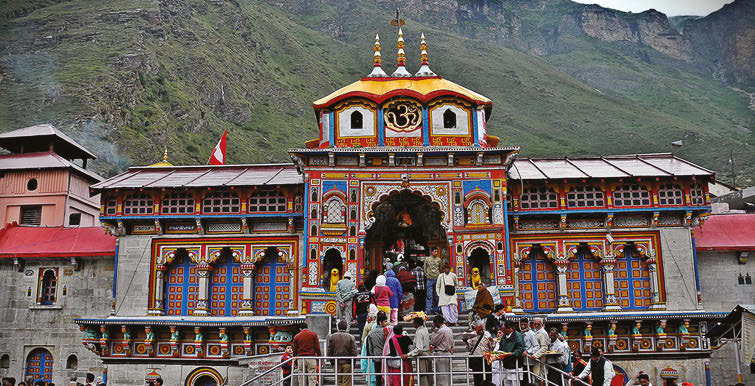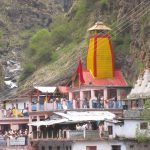
#CharDham is referred to the four Hindu religious sites in Uttarakhand state of India. These are Yamunotri, Gangotri, Badrinath and Kedarnath. Nestled in the lap of majestic Himalayas, these four sites are the epicenter of religious activity in north India. Traditionally, the Chardham yatra is undertaken from the west to the east. Thus, the yatra starts from Yamunotri, then proceeding to Gangotri and finally to Kedarnath and Badrinath.
Amongst the four Char Dhams, Yamunotri and Gangotri are dedicated to goddesses Yamuna and Ganga respectively. On the other hand, Kedarnath is dedicated to Lord Shiva while Badrinath is dedicated to Lord Vishnu. Moreover, people also visit Hemkund Sahib in the vicinity, which is one of the highest located religious sites in the country. Thus, pilgrims visit all these places in aspiration of washing away their sins and to attain salvation, by the blessings of the Lord.
Owing to the significance of this religious circuit, devotees from all over the world, come here to experience the eternal bliss. Char Dhams are hustling and bustling with activity during the summer months, as hundreds of devotees embark upon the holy journey. The picturesque surroundings of the mountainous region are simply enthralling, giving the visitors a perfect opportunity to unwind themselves by filling their lungs with fresh air. Moreover, these otherwise silent and tranquil locales resound with the names of the Lord as the pilgrims advance towards their destination.
Badrinath
Badrinath Temple is one of the holiest Hindu shrines in India. It is situated in the hill town of Badrinath in the Chamoli district of Uttarakhand state. Along the river Alaknanda, the temple is essentially a Lord Vishnu shrine. Also known by the names Badri Vishal and Badrinarayan, it is one of the Char Dham sites and the one amongst 108 Divya Desams. This has contributed to the fact that Badrinath is vital with reference to travel and tourism.
The gates of the temple are open only for a period of six months, due to extreme weather conditions in Himalayas. There are a number of hot water pools here namely Tapt Kund, Narad Kund etc. These pools are filled with hot steaming water in the winter months also and are considered to posses medicinal properties. Many people even perform the last rites of the departed souls at Brahm Kapal.
It is a flat platform on the banks of river Alaknanda. Sheshnetra and Chandrapaduka are other rock boulders present along the river, which are believed to have footprints of Shesh Nag and Lord Vishnu. Another important temple here is the Mata Murti Temple. These temples are also considered as evidences of the rich historical past of Badrinath. Referring the mythological facts, it is believed that Lord Vishnu was practicing penance at this place.
In order to save him from the harmful rays of the sun, his divine consort Lakshmi took the form of a Badri plant and provided shade to him. Pleased by her fervor and devotion, the Lord told her that this place would be famous by her name. Hence, it came to be known as Badrinath. Splashed by Alaknanda, the divine site serves as an ideal location to experience the eternal bliss associated with spirituality.
Kedarnath
Kedarnath is a sacred town situated in the state of Uttarakhand of India. It can even be called as one of the remotest Char Dham sites as it is located amidst the snow-capped mountains of Himalayas, near the river Mandakini. Nestled in the Rudraprayag district, the main attractions here is the Kedarnath Temple, which is a popular Hindu shrine and pilgrimage, attracting devotees from all over the world. The travel and tourism scope here is strengthened by factors like natural beauty and religious zest.
The Kedarnath Temple is dedicated to Lord Shiva and is deemed to have been built by Adi Sankaracharya. The glory of the temple can be attributed to the fact that it is one of the twelve jyotirlingas (Lord Shiva shrines), present in the country. The temple remains open only for a period of six months, due to heavy snowfall in the winter months. Testing the fervor and dedication of the pilgrims, the temple is not directly reachable by road.
The only way being, a 14 km trek path from Gaurikund. The present temple stands adjacent to the initial temple built by the Pandavas. According to historical data, Pandavas after winning the battle of Mahabharata, felt guilty of killing their own brothers. They came here in search of Lord Shiva, who kept hiding himself. Finally Bhima, the strongest Pandava brother recognized him. Lord Shiva, who was disguised as a bull, escaped leaving behind his hind part.
This led to the construction of the temple here. The present Kedarnath Temple has been built by huge slabs of gray stones, standing undeterred with all its glory and majesty. The divine peace and tranquility of the place leaves the devotees completely mesmerized. The haunting environment and secluded surroundings compel all the visitors to feel the inner connection with the Almighty. Thus, Kedarnath is considered a must visit place amongst pilgrims, before leaving this world.
Gangotri
One of the four sites amongst the holiest places, Char Dham in India, is Gangotri. This sacred city is located in the northern part of the state of Uttarakhand. It is known as the source of River Ganges and also the seat of Goddess Ganga. Ducked amidst the sprawling Garhwal hills, Gangotri is an ideal location for all those who wish to take a dip into the oceans of divinity, as well as those have a thirst for adventure. This makes Gangotri an ideal spot in terms of travel and tourism.
Gangotri also has a strong historical past and bears the eternal feel of antiquity. According to mythological records, King Bhagirath did penance here, after which, as per Lord Shiva’s wishes, River Ganges came down on earth. However, to save the earth from the fierce force of the river, Lord Shiva held her in his locks. Thus, river Ganges is also known as Bhagirathi here. Moreover, it is also believed that Pandavas came down to this place to perform Deva Yajna.
As a result, Gangotri is a significant place from religion point of view. Hundreds of devotees throng the place every year in order to unleash the secrets of spirituality. Some of the main attractions of Gangotri include Gangotri Temple, which was built by Gurkha monarch Amar Singh Thapa, around 3000 years back. Another pilgrim site here is Jalamagna Shivalinga, which is a natural rock Shivalinga submerged in the river.
It is deemed to be the place where Lord Shiva held Ganga in his locks. This Shivalinga is only visible in winter months. Other worth visiting places in the vicinity are Gaumukh (source of Ganges), Gaumukh Glacier and Nandanvan. Drifting towards the adventurous aspect of Gangotri, it offers a number of sports for fun lovers such as river rafting, trekking etc. Thus, to enjoy the natural beauty and religious fervor at its best, Gangotri is a must visit place for all.
Yamunotri
Perched amidst sprawling Garhwal Hills, Yamunotri is another revered pilgrim spots in the state of Uttarakhand. It is one of the Char Dham in India and holds great religious importance. Yamunotri is the source of sacred river Yamuna and also the abode of goddess Yamuna. It is famous for its thermal springs, glaciers and scenic locales. In effect, it is one of the must visit places from travel and tourism point of view.
According to Hindu mythology, this hilly spot was once the abode of an ancient sage by the name, Asit Muni. Owing to its legendary significance, thousands of devotees visit this silent yet hustling-bustling pilgrimage place. There are a many worth visiting places here, one of the most important being the Yamunotri temple. This temple was built by Maharani Gularia of Jaipur in the 19th century. The shrine is dedicated to goddess Yamuna.
She resides here in the form of a silver idol adorned with garlands. It is believed that a holy dip in the sacred water of river Yamunotri here relieves everyone from a painful death. This is because she is the sister of Yama, the God of Death. As a result, pilgrims visit the place in order to seek the blessings of Yamuna and save themselves from the agony of death. Apart from this there is Surya Kund which is known for its thermal springs.
The temperature of the water here is approximately 190 degree Fahrenheit. Also, there are a number of hot water pools here, which are used to cook rice and potato as Prasad (holy offerings to God). Divya Shilla is a rock pillar here, which is worshipped by the devotees before entering the Yamunotri temple. Other tourist places near Yamunatri are Janaki Chatti, Hanuman Chatti and Saptrishi Kund.








Be the first to comment